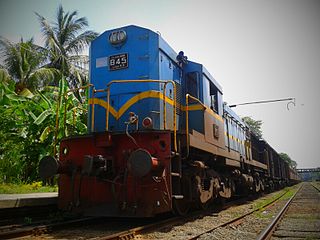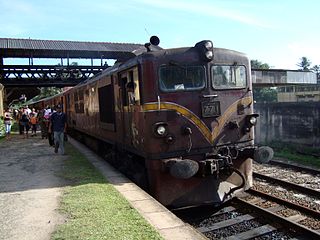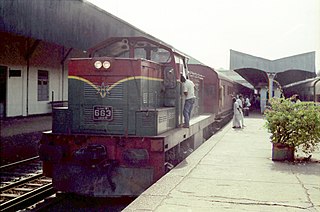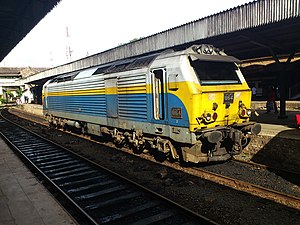
A locomotive is a rail transport vehicle that provides the motive power for a train. If a locomotive is capable of carrying a payload, it is usually rather referred to as a multiple unit, motor coach, railcar or power car; the use of these self-propelled vehicles is increasingly common for passenger trains, but rare for freight trains.

A railbus is a lightweight passenger railcar with an automotive engine. It shares many aspects of its construction with a bus, typically having a bus body and four wheels on a fixed base instead of on bogies. Originally designed and developed during the 1930s, railbuses have evolved into larger dimensions with characteristics similar in appearance to a light railcar, with the terms railcar and railbus often used interchangeably. Railbuses designed for use specifically on little-used railway lines were commonly employed in countries such as Germany, Italy, France, the United Kingdom, and Sweden.

The Northern Ireland Railways DH class was a class of three diesel-hydraulic shunting locomotives obtained in 1969. All three have now been withdrawn, and two have since been rebuilt for work in Sri Lanka.

The Indian locomotive class WDM-2 is a class of diesel-electric locomotive that was developed in 1962 by American Locomotive Company (ALCO) for Indian Railways. The model name stands for broad gauge (W), Diesel (D), Mixed traffic (M) engine, 2nd generation (2). They entered service in 1962. A total of more than 2,700 WDM-2 was built at ALCO and Banaras Locomotive Works, Varanasi between 1962 and 1998, which made them the most numerous class of mainline diesel locomotive until its successor the WDM-3A.
The ALCO DL560C is a series of diesel-electric locomotive with AC electric transmission designed by the American Locomotive Company and produced under license by Banaras Locomotive Works (BLW) Varanasi, India for Indian Railways as their classes WDM-2, WDM-3A/2C, WDM-3D and WDG-3A for operation in India. The locomotive is fitted with a 16-cylinder ALCO 251 B, C diesel engine. In the early 1960s Indian Railways needed a reliable diesel workhorse to gradually replace its steam locomotive fleet. Equal numbers of ALCO's DL560C and EMD's G16 were chosen for trials. More locomotives of each of these were purchased for more trials. Indian Railways was keen on producing these locomotives in the country rather than depending on imports. EMD did not agree for a Transfer-of-Technology, while ALCO did. Thus ALCO DL560C was chosen for the job due to its easy maintenance, reliability and simple operation. And from then on vast numbers of this loco in different configurations have been produced and remain the main diesel traction power of Indian Railways.

The Sri Lanka Railway Department is Sri Lanka's railway owner and primary operator. As part of the Sri Lankan government, it is overseen by the Ministry of Transport. Founded in 1858 as the Ceylon Government Railway, it operates the nation's railways and links Colombo with other population centres and tourist destinations.

Advanced steam technology reflects an approach to the technical development of the steam engine intended for a wider variety of applications than has recently been the case. Particular attention has been given to endemic problems that led to the demise of steam power in small- to medium-scale commercial applications: excessive pollution, maintenance costs, labour-intensive operation, low power/weight ratio, and low overall thermal efficiency; where steam power has generally now been superseded by the internal combustion engine or by electrical power drawn from an electrical grid. The only steam installations that are in widespread use are the highly efficient thermal power plants used for generating electricity on a large scale. In contrast, the proposed steam engines may be for stationary, road, rail or marine use.

The Prima Diesel-electric locomotives are a class of medium and heavy, four- and six-axle, passenger and freight mainline locomotives. They have been built both to 1,435 mm standard and 1,668 mm broad gauges, and find use in the Middle East, Europe and North America. Alstom is the primary designer in cooperation with both General Motors and Siemens.
The RK 215 is a line of diesel engines built by MAN. The RK 215 series is a large four-stroke diesel engine that has an 11-liter displacement per cylinder.

Locomotives and train sets of Sri Lanka Railways consist mostly of diesel locomotives and multiple units. Steam locomotives are no longer used, except on heritage trains, such as the Viceroy Special.

The northern line is a railway line in Sri Lanka. Branching off the Main Line at Polgahawela Junction the line heads north through North Western, North Central and Northern provinces before terminating at the northern port of Kankesanthurai. The line is 339 kilometres (211 mi) long and has 55 stations between Polgahawela Junction and Vavuniya. It is the longest railway line in Sri Lanka. The line opened in 1894. Major cities served by the line include Kurunegala, Anuradhapura, Vavuniya,Kilinochchi and Jaffna. The popular Yal Devi service operates on the line. The line was severely affected by the civil war and no services operated north of Vavuniya after 1990. Reconstruction of this section of the line commenced following the end of the civil war in 2009 and was fully completed in early 2015.

The Batticaloa line is a railway line in Sri Lanka. Branching off the Northern line at Maho Junction, the line heads east through North Central Province and south-easterly through Eastern Province before terminating at the eastern city of Batticaloa. The line is 212 kilometres (132 mi) long and has 31 stations. The line opened in 1928. There were no services on the Polonnaruwa-Batticaloa stretch of the line between 31 October 1996 and 12 April 2003 due to the civil war. The Udaya Devi service operates on the line.

The Main Line is a major railway line in the rail network of Sri Lanka and considered by many to be one of the most scenic train journeys in all of Asia. The line begins at Colombo Fort and winds through the Sri Lankan hill country to reach Badulla.

The Sri Lanka Railways Class M2 is a class of diesel-electric locomotive that was developed in 1954 by General Motors Diesel, Canada, and Electro-Motive Division, USA. This is considered one of the most successful locomotives in Sri Lanka.

Sri Lanka Railways Class M8 is a class of Sri Lankan diesel-electric locomotive that was developed by Banaras Locomotive Works at Varanasi, India, in 1996. This class of locomotives was fitted with 2,800 hp (2,100 kW) V16 power units. This is used on both passenger and freight trains on Sri Lanka Railways.

Class S10 is a diesel multiple unit (DMU) train, built for Sri Lanka Railways by China South Locomotive & Rolling Stock Corporation and imported in 2008. Fifteen S10 DMUs were ordered to strengthen commuter services on the main line. These DMUs are with advanced technical features and S10s do considerable service in SLR schedule.

The Sri Lanka Railways Class M5 is a type of diesel-electric locomotive. The class was ordered to strengthen the diesel locomotive fleet of Sri Lanka Railways.

The Sri Lanka Railways Class W1 is a class of Sri Lankan diesel hydraulic locomotive that was built by Rheinstahl Henschel in 1969. A total of 45 W1s were built and imported. This is the first diesel-hydraulic locomotive which ran on Sri Lankan rail.

The Sri Lanka Railways W2 is a class of diesel-hydraulic locomotives built by LEW Hennigsdorf for Sri Lanka Railways.

The Indian locomotive class WDM-3D is a class of diesel-electric locomotive that was developed in 2003 by Banaras Locomotive Works (BLW), Varanasi for Indian Railways. The model name stands for broad gauge (W), Diesel (D), Mixed traffic (M) engine with 3300 horsepower (3D). The engine is classified WDM-3D though it outputs only 3300 hp and not 3400 hp as the name should suggest. They entered service in 2003. A total of 590+ WDM-3D were built at Banaras Locomotive Works (BLW), Varanasi between 2003 and 2016.




















